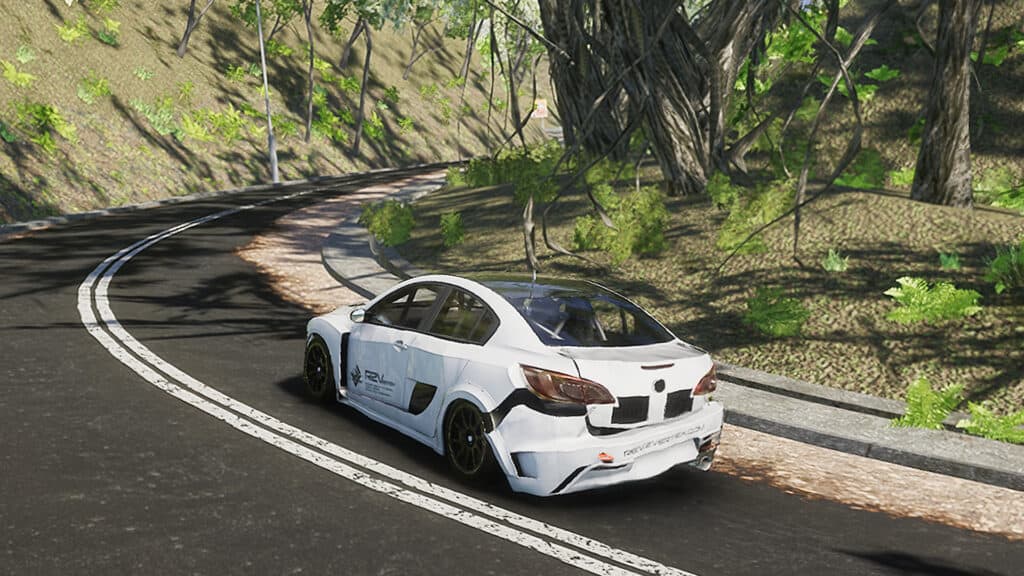Back in February of this year, I had the opportunity to try out Touge racing sim Rev to Vertex, and let’s just say I didn’t walk away from the experience all that impressed.
The demo was beset with performance issues: choppy framerates, controller problems and disappointing sounds. There was some promise there; the graphics looked tidy, for example, and touge racing featuring in a standalone title is an intriguing concept.
Now, however, Hong Kong-based development studio PLUTONIZATION has returned with an updated demo – Rev to Vertex Prologue. The question is, has it improved in the last few months?

3…2…1..NO
Things get off to a confusing start with a set-up screen to change audio, graphics and controller options, with no immediate option to drive. The initial Rev to Vertex (RTV) demo was an absolute chore to set up, but after a brief familiarisation period in Prologue, I could set up my DualShock 4 and start the game. An encouraging start.
What followed was a loooooooong loading period (bear in mind I used a more-than-decent gaming laptop with a speedy SSD for this test) leading to a messy home screen displaying nine race events to sample.
Selecting the first race, driving what looked like a souped-up Mazda 3 – called the MZ3 Cup in-game – the lack of controller speed sensitivity sadly reminded me of RTV’s demo. Framerate was also jumpy, with frequent screen-tearing.
The first practise session was just a full-throttle pass through a couple of corners, taking just over 20s to complete. Was that it? However, this highlights Prologue’s increased car count, with three more vehicles than the early demo version of RTV (including a hotter version of the front-wheel-drive Mazda clone).
Frustratingly, changes made to the controls’ speed sensitivity settings don’t save, and its effects are minimal anyway, meaning playing Prologue with a gamepad was rarely enjoyable. Although we have yet to sample Prologue with a steering wheel peripheral, the demo version was beset with configuration and recognition problems. Hopefully these winkles have since been ironed out.
Replays show off the game’s visual tricks (not including the awful spark effects), but will also randomly display your wheels pointing in the opposite direction to where the car is travelling. It’s immersion-breaking, to say the least, but the damage effects do look pretty from the outside.
Engine sounds for the cars are passable if heavily digitised, with a neat damage model adding some realism to your road sign destruction (which British viewers will recognise owing to Hong Kong’s historic position as a British colony).

Street touge
For the uninitiated, touge racing is essentially fast-paced mountain pass driving (or drifting). Made famous in Japan by the Initial D manga series and its surrounding car culture, Rev to Vertex aims to simulate this experience, starting with the Tsuen Wan Section of Route Twisk in Hong Kong (where PLUTONIZATION is based).
It’s here where Prologue bases its nine point-to-point stages, with Gold, Silver and Bronze level times to beat, thereby unlocking the ninth and final level. You’ll want to drive as smoothly as possible, however, as drifting is a bit of a no-no with such shonky controls.

However, in the rare moments when you can control the car there appears to be a decent handling model tucked away in the background – it’s just really hard to find.
The final game will feature car modification mechanics, with the vehicles already in-game (MZ3 Cup, MZ3-TA, ZZT GT3, NA2 GT1 and A80 GT1) looking aggressive and like fully paid-up members of the Mid Night Club. If PLUTONIZATION can nail the street racing vibe they’ll be on to a winner.
At the moment though, why wouldn’t you just pick up a copy of Assetto Corsa and download some high-quality street-racing mods? That will be RTV’s biggest issue in the marketplace, I fear.

There’s even a real-time tyre widget on the bottom left of the screen, showing tyre and brake temperatures, with cold tyres feeling much more nervous to drive on than warm ones. It’s a feature reflecting RTV’s strive for simulation, something we really want to get onboard with.
Final countdown
With no ability to set deadzones or control the rate at which your car turns, I found Prologue to difficult to play with a gamepad. It shares many of the issues we reported on from the demo – difficult controls and poor graphical performance most of all.
Visuals are tje biggest issue however, but in terms of smoothness, not fidelity. Prologue looks rather pretty on higher settings to be honest, but such settings render the game unplayable for me.

Although the system I used is modest by hardcore gaming standards it’s still well capable of running the resource-intensive BeamNG.drive at 60FPS on high settings. So, a single car on a single track (on medium graphics settings) should not run as poorly as this. RTV’s recommended system requirements include a GeForce RTX 3080 graphics card, which tells its own story.
However, PLUTONIZATION is a small dev team with a handful of employees, so the fact such an impressive-looking game exists is an achievement in itself. And as we reported earlier today, Rev to Vertex is set to release in full at the end of June. I can’t help but feel the team needs a lot more time to get things right.
The free Rev to Vertex Prologue is available to download and try for PC (Steam) now.
Have you sampled it? Let us know how your thoughts in the comments below.





















